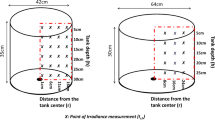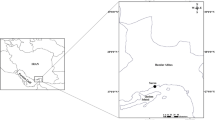Abstract
The agarophyte red seaweed Gracilaria conferta was used as a model plant to study the relationship between growth and environmental factors. This species was cultured in small outdoor tanks with continuous seawater supply during three years. Seaweeds were kept under constant density by weekly thinning and were also pulse-fed weekly with nitrogen and phosphate. Water temperature and underwater irradiance increase had opposite effects on the weekly growth rate in two seasons: negative in summer and positive in non-summer. Therefore, a dichotomic separation between summer (June–August) and non-summer (September–May) seasons was utilized in the proposed linear model. The linear model, of the analysis of covariance type, accounted for an explained percentage of total variation (R2) of 0.567, with significant coefficients of all variables included. A standardized model showed that season was the dominant variable, with its coefficient being twice that of temperature in summer, and zero in the non-summer season. Water temperature affected the growth rate twice as much as irradiance, and epiphytes showed a significant negative effect on growth only in the summer. This model aids in the prediction of growth on a seasonal basis under local conditions.
Similar content being viewed by others
References
Doty, M. S., T. J. F. Caddy & B. Santelices, 1986. Case studies of seven commercial seaweed resources. FAO Fish. Tech. Pap. 281, 311 pp.
Friedlander, M., R. Shalev, T. Ganor & S. Strimling, A. Ben-Amotz, H. Klar & Y. Wax, 1987. Seasonal fluctuations of growth rate and chemical composition of Gracilaria cf. conferta in outdoor culture in Israel. Proc. int. Seaweed Symp. 121: 501–507.
Hanisak, M. D., 1979. Growth patterns of Codium fragile ssp. tomentosoides in response to temperature, irradiance and nitrogen source. Mar. Biol. 50: 319–332.
Hanisak, M. D. & J. H. Ryther, 1984. Cultivation biology of Gracilaria tikvahiae in the United States. Proc. int. Seaweed Symp. 11: 295–298.
Sokal, R. R. & F. J. Rohlf, 1981. Biometry. 2nd edition. Freeman & Co., San Francisco, CA, 859 pp.
Author information
Authors and Affiliations
Rights and permissions
About this article
Cite this article
Friedlander, M., Galai, N. & Farbstein, H. A model of seaweed growth in an outdoor culture in Israel. Hydrobiologia 204, 367–373 (1990). https://doi.org/10.1007/BF00040258
Issue Date:
DOI: https://doi.org/10.1007/BF00040258




